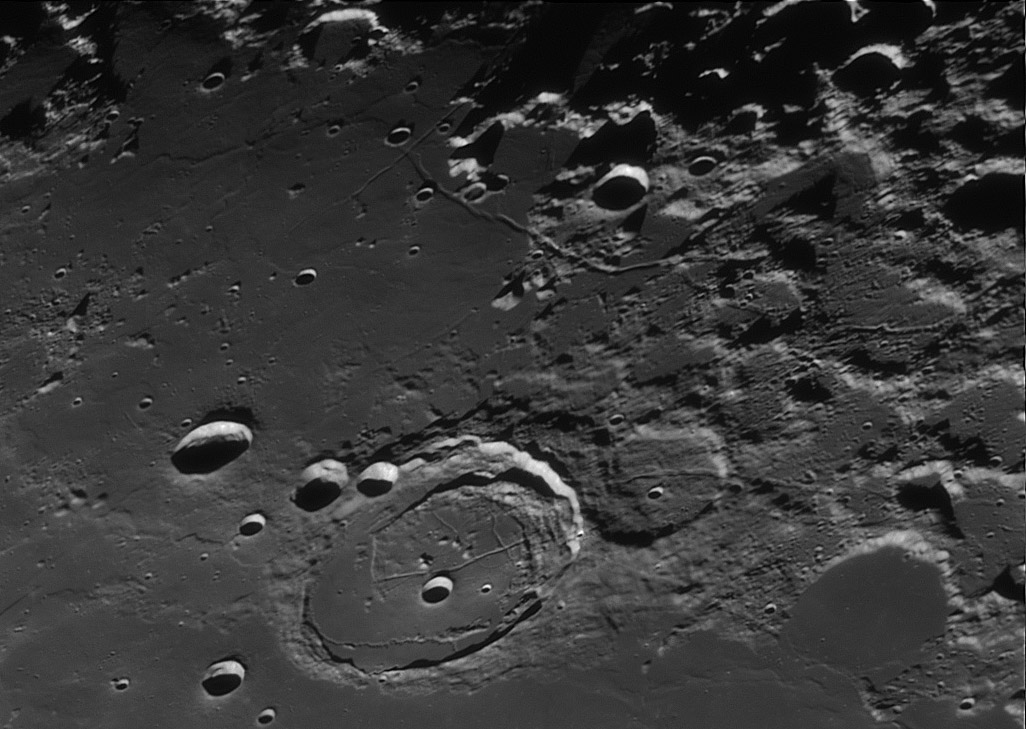Difference between revisions of "November 1, 2008"
| Line 16: | Line 16: | ||
<br /> | <br /> | ||
<strong>Related Links</strong><br /> | <strong>Related Links</strong><br /> | ||
| − | Rükl plates [https://the-moon.us/wiki/ | + | Rükl plates [https://the-moon.us/wiki/Rükl_14 14] & [https://the-moon.us/wiki/Rükl_15 15]<br /> |
<br /> | <br /> | ||
<p><b>Yesterday's LPOD:</b> [[October 31, 2008|Sub-Polar Marker]] </p> | <p><b>Yesterday's LPOD:</b> [[October 31, 2008|Sub-Polar Marker]] </p> | ||
Latest revision as of 20:55, 18 August 2018
An Old Fault?

image by Mike Wirths, Baja, Mexico (north to the left)
I was about to crop Posidonius out of this image (to focus on the rilles), but then I realized its importance - it is a guidepost to a suspicious straight line. On the upper right side of Posidonius' rim, running right up the center of the image is a straight boundary between mountain terrain to the right and lowland maria to the left. Remote sensing geologists often map such straight boundaries seen on the Earth as likely faults because most other geologic processes don't make linear edges. Hold a business card up to to your monitor to confirm how straight this is. And notice other lineations (the geologic jargon for a straight feature of uncertain origin) aligned in the same direction. See how the G. Bond rille is offset where it crosses the putative fault? And notice a few kilometers to the left how the rille has two more offsets parallel to the first. If you squint you can see a straight line extending both up and down from the bigger offset, exactly parallel to the proposed main fault. And on the floor of the breached-rim Hall crater there is a short segment of a wide-floored rille that continues the trend of the main fault, but is offset to the right. Look closely and you can see all of these lineations (and others associated with the G. Bond rille running in other directions). The main straight boundary extending up from Posidonius and all the other smaller lines parallel to it are approximately radial to the center of the Serenitatis Basin. Notice also that the Cauchy Rille (and almost the Cauchy Fault) in nearby Mare Tranquillitatis are radial to Serenitatis. Are these features fractures in the crust related to the formation of the basin? Yes.
Chuck Wood
Can't find Hall crater? Click the "15" on the Related Links below.
Technical Details
October 18, 2008, 6:00-6:30 pm pacific time. 18" Starmaster + 2.5 Televue barlow + Infinity 2-2 camera + R/IR true tech filter. Processed in Registax 4 and PS CS.
(Also note the cone of light extending from the rim of Hall toward the terminator - neat).
Related Links
Rükl plates 14 & 15
Yesterday's LPOD: Sub-Polar Marker
Tomorrow's LPOD: A Wallfull of Rükl
COMMENTS?
Register, Log in, and join in the comments.



